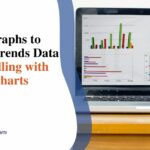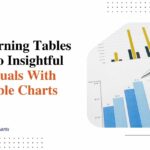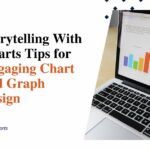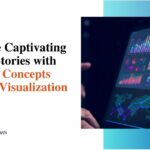The Must-Have Guide for Effective Data Storytelling: ‘Storytelling with Data
Navigating the world of data can often feel like trying to read a treasure map penned in an unfamiliar script. Trust me, it’s a sentiment I recognize all too well from the beginning of my own journey into weaving narratives with numbers and charts.
That’s when I stumbled upon Brent Dykes’ game-changing book “Storytelling with Data”. In this blog post, we’ll delve into key elements and techniques from his invaluable guide—tools that will empower you to spin your own convincing tales using data as your thread.
Ready for this exciting transformation? Let’s embark on our adventure into crafting compelling narratives!
Key Takeaways
- Data, narrative, and visuals are essential elements of effective data storytelling.
- Effective data storytelling has the power to drive change, inspire action, and enlighten audiences.
- To craft effective data stories, it is important to understand your audience, simplify complex data, use visuals to enhance understanding, and employ a narrative structure.
- Examples of effective data storytelling include using best practices for data visualization and examining real-world case studies.
Essential Elements of Data Storytelling
To effectively communicate with data, three essential elements must be present: the data itself, a compelling narrative, and impactful visuals. These elements work together to create a powerful data story that can drive change, inspire action, and enlighten audiences.
Data
Data is the backbone of any story we tell with numbers. It is the facts and figures that we base our story on. These are not just random bits, but key points that matter to us. They give us a deeper look into what’s going on and can help show trends or changes over time with charts and graphs.
Using data well means finding which parts are important to share. Not every bit will be useful in our tale, so it’s crucial to pick out those parts that carry weight and add depth to our stories.
Narrative
Narrative plays a crucial role in effective data storytelling. It is the way we structure and present our data to create a compelling story that engages and resonates with our audience.
By using narrative techniques, we can make complex data more accessible and understandable for others. The book “Storytelling with Data” emphasizes the importance of telling a clear and cohesive story through your data.
It explains that narratives should have essential elements such as a main point or message, an explanatory focus, a linear sequence, and even some dramatic effect to capture attention.
Visuals
Visuals play a crucial role in effective data storytelling. They help to enhance understanding and make the data more memorable for the audience. By using appropriate visuals such as graphs, charts, and infographics, you can present complex data in a simplified and compelling way.
Visuals also provide supporting evidence that adds credibility to your data story. In the book “Storytelling with Data,” Brent Dykes emphasizes the importance of choosing the right type of visual representation based on your data and main point.
It is essential to ensure that your visuals are clear, easy to interpret, and aligned with your narrative to effectively communicate insights from the data.
The Power of Effective Data Storytelling
Effective data storytelling has the power to drive change, inspire action, and enlighten audiences.
Driving Change
Driving change is one of the powerful outcomes of effective data storytelling. By presenting compelling narratives and visualizations, data stories have the ability to influence decision-making, inspire action, and bring about transformation in organizations.
Through data insights and analysis, business professionals can communicate the need for change in a clear and persuasive manner. Data-driven stories provide evidence that supports the case for change and helps stakeholders understand the impact it can have on their goals.
With effective communication techniques, such as simplified data visuals and a well-structured narrative, data storytelling becomes a catalyst for driving positive change within an organization or community.
Inspiring Action
Effective data storytelling has the power to inspire action. When we present our data in a compelling and engaging way, it can motivate others to take meaningful steps based on the insights we’ve uncovered.
By using narratives and visuals that resonate with our audience, we can generate excitement and drive change.
When crafting our data stories, it’s important to consider how we can spark action. We can do this by focusing on the main points that will have the greatest impact and presenting them in a way that is easy to understand.
By simplifying complex data and using visuals to enhance understanding, we make it easier for people to grasp the significance of the information presented.
Additionally, incorporating a narrative structure into our data stories helps create an emotional connection with our audience. When people feel personally invested in the story being told, they are more likely to be inspired and motivated to act upon what they learn from the data.
Enlightening Audiences
Data storytelling is a powerful tool for enlightening audiences. By using data, narrative, and visuals effectively, you can communicate insights in a clear and engaging way. When you craft your data stories with the audience in mind, you can present complex information in a simplified manner that resonates with them.
Additionally, by using compelling visuals and a well-structured narrative, you can capture their attention and make the data more understandable and memorable. Through effective data storytelling, you have the ability to inspire curiosity, spark discussions, and ultimately enlighten your audience with valuable insights from the data.
Tips for Crafting Effective Data Stories
Crafting effective data stories requires understanding your audience, simplifying complex data, using visuals to enhance understanding, and employing narrative structure. These tips will help you communicate your data effectively and inspire action.
Read on to learn more!
Understand your audience
To effectively communicate with data, it is crucial to understand your audience. This means knowing who they are, what their needs and interests are, and tailoring your data story accordingly.
By understanding your audience, you can determine the level of detail and complexity that is appropriate for them. For example, if you are presenting to business professionals who may not have a strong background in data analysis, you will need to simplify complex concepts and use visuals to enhance understanding.
On the other hand, if you are speaking to experts in the field, you can delve into more technical details. Understanding your audience allows you to deliver a compelling data story that resonates with them and drives change or inspires action based on their specific needs and interests.
Simplify complex data
Data can sometimes be complicated and overwhelming, especially when dealing with large amounts of information. But in order to effectively tell a story with data, it’s important to simplify complex data.
This means breaking it down into smaller, more manageable pieces that are easier for the audience to understand. By simplifying the data, we can highlight the most important insights and make them more accessible to others.
This could involve using clear and concise visuals, such as charts or graphs, that present the data in a visually appealing way. It could also mean using plain language explanations and avoiding technical jargon that might confuse the audience.
Simplifying complex data allows us to convey our message clearly and ensures that our audience can easily grasp the key takeaways from the data story.
Remember:
Use visuals to enhance understanding
Visuals play a crucial role in effective data storytelling. They help to enhance understanding by presenting complex information in a way that is easy to grasp. When crafting data stories, it’s important to use visuals such as graphs, charts, and infographics.
These visual representations make it easier for the audience to interpret and remember the information being presented. Additionally, visuals can also help highlight key insights and trends in the data, making the story more persuasive and impactful.
By using visuals effectively, you can engage your audience and ensure that your message gets across clearly and memorably.
Use narrative structure
In data storytelling, using a narrative structure helps to engage and captivate your audience. It involves presenting the data in a logical sequence that tells a story with a clear beginning, middle, and end.
By framing your data within a narrative structure, you can guide your audience through the insights and conclusions you want to convey. This approach helps them understand the context, follow the flow of information, and connect emotionally with the story behind the data.
By incorporating elements such as characters, conflicts, and resolutions into your narrative, you can make your data stories more relatable and memorable for your audience. Overall, using a narrative structure allows you to present information in an engaging way that resonates with your audience’s emotions and experiences.
Examples of Effective Data Storytelling
Data visualization best practices and real-world case studies will be examined to illustrate the power of effective data storytelling.
Data visualization best practices
Data visualization is a key aspect of effective data storytelling. To ensure that your visualizations are impactful and easily understood, there are some best practices to keep in mind.
First, it’s important to choose the right type of visualization for your data. This means selecting a chart or graph that accurately represents the relationships or patterns in your data.
Second, keep your visualizations simple and uncluttered. Avoid using unnecessary elements or excessive colors that can distract from the main message. Third, use labels and captions to provide context and make it clear what the viewer should focus on.
Lastly, make sure your visualizations are accessible by considering colorblindness and other accessibility needs.
- Real-world case studies
Real-world case studies
Real-world case studies are powerful examples of how effective data storytelling can drive change, inspire action, and enlighten audiences. These case studies showcase the practical application of data storytelling techniques in various industries and contexts.
They demonstrate how businesses have used data narratives and visualizations to communicate complex information effectively. By examining these real-life examples, readers can gain insights into best practices for crafting compelling data stories that resonate with their own audiences.
These case studies serve as inspiration and provide tangible evidence of the impact that persuasive data storytelling can have on decision-making processes.
Conclusion
In conclusion, “Storytelling with Data” is an invaluable guide for mastering the art of effective data storytelling. By combining data, narrative, and visuals, business professionals can drive change, inspire action, and enlighten audiences.
This book provides tips for crafting compelling stories that simplify complex data and use visuals to enhance understanding. With real-world examples and best practices in data visualization, readers can become skilled at communicating insights through memorable and persuasive data stories.
It’s a must-have resource for anyone looking to harness the power of data storytelling.
FAQs
1. What is ‘Storytelling with Data’?
‘Storytelling with Data’ is a guide for effective data storytelling. It teaches visual communication and data visualization to tell memorable data stories.
2. How can the guide help my business?
This guide can teach you how to drive change with data in your business. By using persuasive storytelling, you can better understand and use your data.
3. Why are visual communication and info design important in telling stories with data?
Visual communication and information design are key parts of narrative storytelling with data. They make complex information easy to understand and remember.
4. Can I learn how to interpret my business’s own data from this guide?
Yes, this must-have guide not only includes tips on creating memorable stories but also helps improve skills in interpreting your own business-related datasets
5.What does the term “data-driven storytelling” mean?
Data-driven storytelling involves using your company’s actual numbers or facts as part of an engaging narrative that informs, persuades or drives action among employees, customers or other stakeholders.







